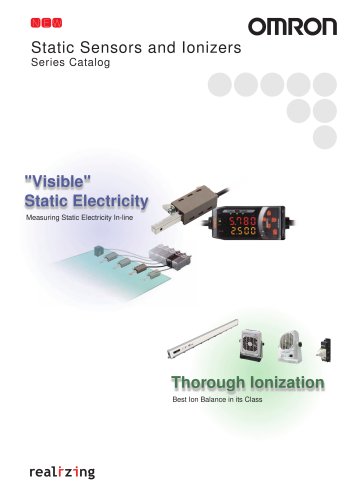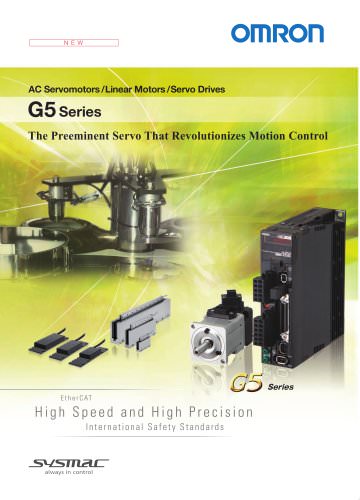
Excertos do catálogo
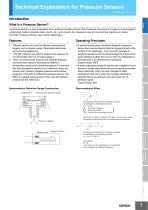
Technical Explanation for Pressure Sensors CSM_Pressure_TG_E_2_2 Introduction Sensors What Is a Pressure Sensor? A pressure sensor is a device equipped with a pressure-sensitive element that measures the pressure of a gas or a liquid against a diaphragm made of stainless steel, silicon, etc., and converts the measured value into an electrical signal as an output. (The E8 Pressure Sensors use a silicon diaphragm.) Operating Principles Semiconductor distortion gauge Control Components Protective film Semiconductor Distortion Gauge Construction • A semiconductor piezo-resistance dispersion pressure sensor has a semiconductor distortion gauge formed on the surface of the diaphragm, and it converts changes in electrical resistance into an electrical signal by means of the piezo-resistance effect that occurs when the diaphragm is distorted due to an external force (pressure). Typical model: E8F2 • A static capacitance pressure sensor has a capacitor that is formed by a static glass electrode and an opposing movable silicon electrode, and it converts changes in static capacitance that occur when the movable electrode is distorted due to an external force (pressure) into an electrical signal. Typical model: E8Y Safety Components 1. Different sensors are used for different measurement targets, such as liquids, gases, flammable substances, and corrosive substances. (The E8 Sensors are used to measure the pressure of non-flammable and non-corrosive gases.) 2. There are sensors that measure the absolute pressure and those that measure the pressure relative to atmospheric pressure or a specified pressure. For sensors that use atmospheric pressure as a reference, there are sensors that measure negative pressures and positive pressures. (The E8Y is a differential pressure sensor. The E8F2 is a gauge pressure sensor that uses atmospheric pressure as the reference.) Automation Systems S The electrical resistance of the above conductor is expressed by the following formula: R = ρ x L/S. ρ: Electrical resistivity L: Conductor length S: Conductor cross-sectional area Motion / Drives When this conductor is pulled to the right or left as shown below, the length increases and the cross-sectional area decreases. Pressure is applied. L+1 Gauge foil pattern Energy Conservation Support / Environment Measure Equipment The electrical resistance of the above conductor is expressed by the following formula: R' = ρ x (L+1)/(S−s). Accordingly, R' > R. This shows how the application of a mechanical force changes the electrical resistance. Power Supplies / In Addition Othe
Abrir o catálogo na página 1
Technical Explanation for Pressure Sensors Reference pressure Gauge Pressure The amount of pressure is expressed in terms of atmospheric pressure. It is referred to as "positive pressure" when it is greater than one atmosphere, and "negative pressure" when it is less than one atmosphere. Absolute Pressure This is the amount of pressure expressed in relation to an absolute vacuum. Pressure Difference (Relative Pressure) This is the amount of pressure compared to any particular pressure (the reference pressure). Negative Positive pressure ! pressure Absolute Atmospheric vacuum pressure...
Abrir o catálogo na página 2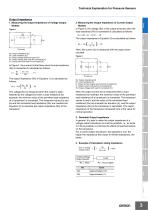
Output Impedance 1. Measuring the Output Impedance of Voltage Output Models Figure 1 The output impedance in Equation (3) is calculated as follows: Ro = Rx (■ - ) (4) The output impedance (Ro) in Equation (1) is calculated as follows: Here, the current (Io) is measured with the output short-circuited. Figure 2 The voltage (Eo) is measured when the output is open, followed by the voltage (Ex) when a load resistance (for example, the minimum value of the permitted load resistance of a transducer) is connected. The measured values Eo and Ex and the connected load resistance (Rx) are inserted...
Abrir o catálogo na página 3Todos os catálogos e folhetos técnicos OMRON
-
Technical Explanation for Fiber Sensors
14 Páginas
-
D4F
8 Páginas
-
D4GS-N
11 Páginas
-
E4E2
5 Páginas
-
Smart Laser Sensors E3NC-L/E3NC-S
16 Páginas
-
Fiber SensorBest Selection Catalog
104 Páginas
-
Fiber Unit E32-LT/LD
4 Páginas
-
G9SE Series
20 Páginas
-
NX-SL/SI/SO
20 Páginas
-
G9SP
28 Páginas
-
G9SX-SM
24 Páginas
-
G9SX-SM/LM
9 Páginas
-
G9SX/G9SX-GS
49 Páginas
-
G9SX-LM
28 Páginas
-
G9SB
10 Páginas
-
G9SA
16 Páginas
-
DST1 Series
5 Páginas
-
WS02-CFSC1-E
3 Páginas
-
G9SA-300-SC
9 Páginas
-
K8AK-AS
12 Páginas
-
K8AK-AW
16 Páginas
-
K8AK-VS
12 Páginas
-
K8AK-VW
12 Páginas
-
K8AK-PH
12 Páginas
-
K8DS-PH
12 Páginas
-
K8AK-PM
16 Páginas
-
K8DS-PM
12 Páginas
-
K8AK-PA
12 Páginas
-
K8DS-PA
12 Páginas
-
K8AK-PW
12 Páginas
-
K8DS-PU
12 Páginas
-
K8DS-PZ
12 Páginas
-
K8AK-TS/PT
12 Páginas
-
K8AK-LS
12 Páginas
-
K8AK-TH
12 Páginas
-
K2CM
16 Páginas
-
SE
15 Páginas
-
SAO
13 Páginas
-
APR-S
6 Páginas
-
XS5
25 Páginas
-
XS2
29 Páginas
-
F92A
4 Páginas
-
GLS
3 Páginas
-
TL-L
5 Páginas
-
V680 series
68 Páginas
-
V680S Series
68 Páginas
-
MY
35 Páginas
-
Safety Light Curtain F3SG-R Series
80 Páginas
-
E3NC-L/-S
16 Páginas
-
61F-GPN-BT / -BC
5 Páginas
-
NE1A-SCPU Series
8 Páginas
-
NE1A-SCPU0[]-EIP
8 Páginas
-
NE0A-SCPU01
6 Páginas
-
LY
14 Páginas
-
G2R-[]-S
11 Páginas
-
G7T
7 Páginas
-
G2A
9 Páginas
-
G2A-434
7 Páginas
-
G2AK
7 Páginas
-
MK-S
9 Páginas
-
MK-S(X)
12 Páginas
-
MM
17 Páginas
-
MMK
14 Páginas
-
G4Q
6 Páginas
-
G7Z
9 Páginas
-
G7J
10 Páginas
-
E4B
12 Páginas
-
E4A-3K
9 Páginas
-
E4C-UDA
5 Páginas
-
E6H-C
5 Páginas
-
E6F-C
5 Páginas
-
E6D-C
5 Páginas
-
E6B2-C
5 Páginas
-
E6A2-C
5 Páginas
-
NL
8 Páginas
-
VB
5 Páginas
-
SC
5 Páginas
-
D5F
5 Páginas
-
D5A
8 Páginas
-
E3S-GS3E4
3 Páginas
-
E3S-R
11 Páginas
-
E3S-A
21 Páginas
-
E3S-CL
9 Páginas
-
E3ZM-C
14 Páginas
-
E3T Data Sheet
26 Páginas
-
E3T Series
6 Páginas
-
G5 Series
59 Páginas
-
Sysmac Catalog
410 Páginas
-
VT-X700
6 Páginas
-
E5AC-T
8 Páginas
-
CP1
12 Páginas
-
CP1E
12 Páginas
-
MS4800
40 Páginas
-
VC-DL100
6 Páginas
-
FZ4 Series
42 Páginas
-
ZG2
16 Páginas
-
ZS Series
32 Páginas
-
ZW Series
24 Páginas
-
E9NC-T
2 Páginas
-
Vision System FH series
54 Páginas
-
CompoNet
28 Páginas
-
F3SJ Series Safety Light Curtain
108 Páginas
-
Code Reader/OCR
24 Páginas
-
Fiber Sensor Best Selection Catalog
100 Páginas
-
Portable Multi-logger ZR-RX70
12 Páginas
-
Air Particle Sensor ZN-PD-S
2 Páginas
-
Smart Fiber Amplifier Units E3NX-FA
8 Páginas
-
NT series
18 Páginas
-
Programmable Controller SYSMAC CVM1
16 Páginas
-
Round Water-resistant Connectors
31 Páginas
-
Modular Temperature Controller EJ1
24 Páginas
-
Safety Controller G9SP
28 Páginas
-
E3FA PHOTOELECTRIC SENSORS
24 Páginas
-
Switch Mode Power Supply S8VK-G
22 Páginas
-
Data Logger ZR-RX Series
12 Páginas
-
Programmable Terminals NS Series
57 Páginas
-
DeviceNet Safety System
30 Páginas
-
Switching Power Supplies
16 Páginas
-
Photomicro Sensors
7 Páginas
-
Displacement Sensors
4 Páginas
-
R87F / R87T AC Axial Fans
28 Páginas
-
G9SX-GS Safety Guard Switching Unit
28 Páginas
-
H8PS Cam Positioner
32 Páginas
-
OS32C Safety Laser Scanner
24 Páginas
-
FQ Vision Sensor
17 Páginas
-
UM, MC3 Safety Mat/Safety Mat Controller
19 Páginas
-
ZN-PD Air Particle Sensor
16 Páginas
-
ZUV-C20H / C30H Smart Curing System
14 Páginas
-
E5CC Digital Temperature Controller
38 Páginas
-
S8EX Switch Mode Power Supply
24 Páginas
-
CP1L CP series CP1L CPU Unit
36 Páginas
-
E2EF
8 Páginas
-
FQ2 Smart camera
24 Páginas
Catálogos arquivados
-
SAFETY APPLICATION HANDBOOK
55 Páginas
-
SMART REMOTE I/O
12 Páginas
-
Sensor Accessories
38 Páginas
-
REGULATION SOLUTIONS
24 Páginas
-
Vision Systems
20 Páginas


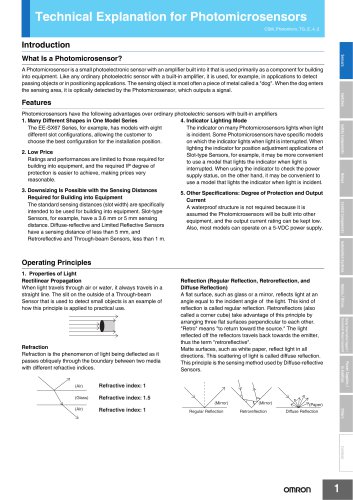


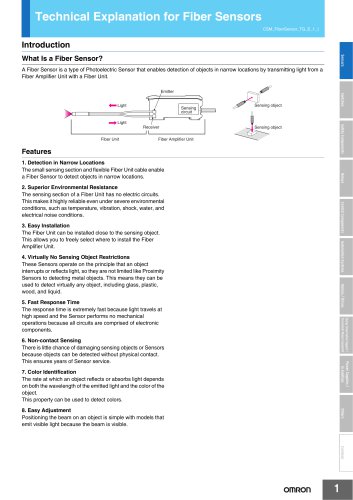



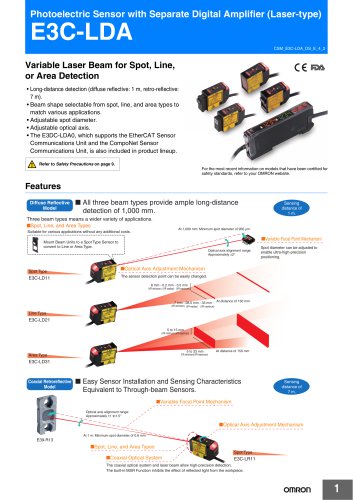



















































![NE1A-SCPU0[]-EIP](https://img.directindustry.com/pdf/repository_di/15954/ne1a-scpu0-eip-616667_1mg.jpg)


![G2R-[]-S](https://img.directindustry.com/pdf/repository_di/15954/g2r-s-616653_1mg.jpg)































































